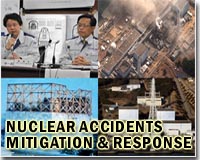| . |  |
. |
Washington (AFP) March 31, 2011 Disaster plans at Japan's stricken Fukushima nuclear plant appear woefully inadequate, including only one satellite phone and a single stretcher in case of an accident, a report said Thursday. Tokyo Electric Power Company's (TEPCO) disaster-readiness plans for Fukushima, which was slammed by Japan's March 11 twin earthquake and tsunami disasters, were obtained by Wall Street Journal. The documents, said the financial daily, focused on smaller-scale accidents but no information on how to confront extensive damage. According to the Journal, the plans had no detail on outside firefighters from Tokyo, the national military force, or using US equipment to battle leaks and contain radiation, which all have been part of the response to the crisis. "The disaster plan didn't function," said a former TEPCO official, quote by the Journal. "It didn't envision something this big." The revelations add to Japanese suspicion over TEPCO's track record on safety issues surrounding Fukushima and attempts to cover them up. In 2002 TEPCO admitted to falsifying safety reports which led to all 17 of its boiling-water reactors being shut down for inspection, including Fukushima. And in an eerily familiar event, a 2007 earthquake paralyzed its Kashiwazaki-Kariwa nuclear plant -- the world's biggest -- and more radiation leaked than TEPCO initially acknowledged. TEPCO later said it underestimated the potential impact of an earthquake on the facility. On Thursday Japanese officials were saying there no plans to widen an exclusion zone around the stricken plant, amid revelations that radiation levels in the sea near the plant had risen to a new high of 4,385 times the legal level.
earlier related report The International Atomic Energy Agency (IAEA) earlier said radiation levels taken at Iitate, located well outside Japan's 20km exclusion zone from the stricken facility, were above its evacuation level. But Japan's nuclear safety agency said there was no need for the several thousand people still in the village northwest of the plant to leave. "The IAEA notice was based on a limited sample and a single reading," agency official Yoshihiro Sugiyama told AFP. "It had an explanatory note that it is necessary to closely follow the situation. We also acknowledge the need to closely follow the situation. "But at the moment, we do not have the understanding that it is necessary to evacuate residents there. We think the residents can stay calm." Authorities later said they would Friday lift restrictions issued earlier on drinking tap water in the village, public broadcaster NHK reported. Norio Kanno, the mayor of the village, which had a pre-disaster population of 6,000, said he was initially "very worried" about the IAEA warning, NHK reported on its website. "But the government immediately informed us that there is no immediate harm to human health, so I was relieved," he said. "Villagers have voiced concern, but the levels of radiation in the tap water and the air are declining. I will carefully monitor them before taking any actions." The Fukushima plant was crippled by a tsunami on March 11 and hit by several explosions, leading to frantic efforts to prevent a catastrophic meltdown as radiation has wafted into the air and seeped into the ocean. Japan has imposed a 20 km exclusion zone around the plant, and also urged people within 30 km to move away. According to Elena Buglova, head of the IAEA's Incident and Emergency Centre, the reading in Iitate village was 2 megabecquerels per square metre. That was a "ratio about two times higher than levels" at which the agency recommends evacuations, she said.
Share This Article With Planet Earth
Related Links Bringing Order To A World Of Disasters A world of storm and tempest When the Earth Quakes
 Japan nuclear refugees feel 'betrayed'
Japan nuclear refugees feel 'betrayed'Yokote, Japan (AFP) March 31, 2011 Refugees who fled Japan's tsunami-hit nuclear reactors say they have been betrayed by the company that runs them, accusing embattled operator TEPCO of creating a "man-made disaster". Tens of thousands of people left their homes near the Fukushima Daiichi nuclear plant after it was crippled by the massive quake and tsunami that hit Japan on March 11, washing away whole towns. Some have ha ... read more |
|
| The content herein, unless otherwise known to be public domain, are Copyright 1995-2010 - SpaceDaily. AFP and UPI Wire Stories are copyright Agence France-Presse and United Press International. ESA Portal Reports are copyright European Space Agency. All NASA sourced material is public domain. Additional copyrights may apply in whole or part to other bona fide parties. Advertising does not imply endorsement,agreement or approval of any opinions, statements or information provided by SpaceDaily on any Web page published or hosted by SpaceDaily. Privacy Statement |